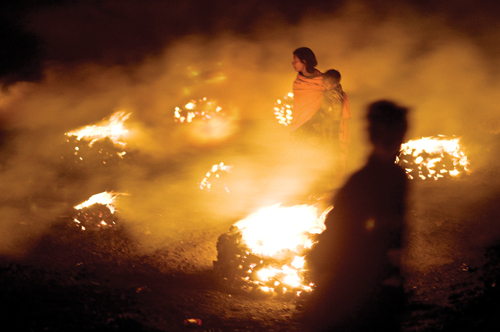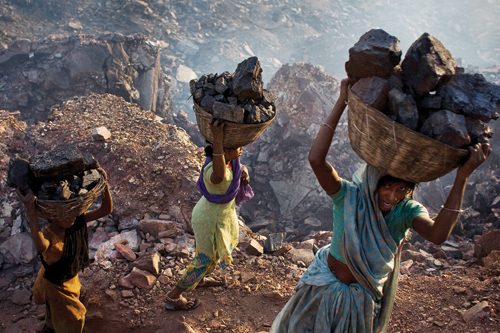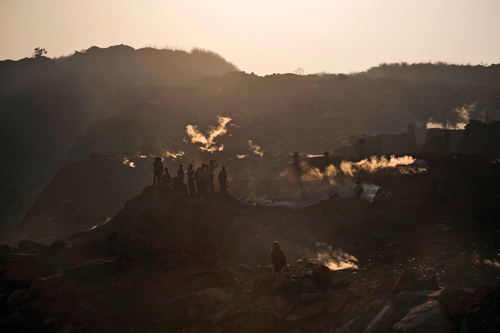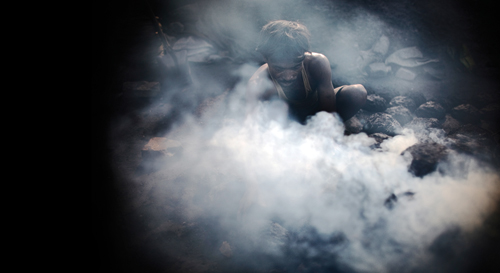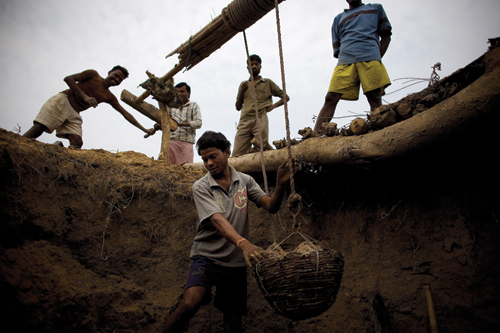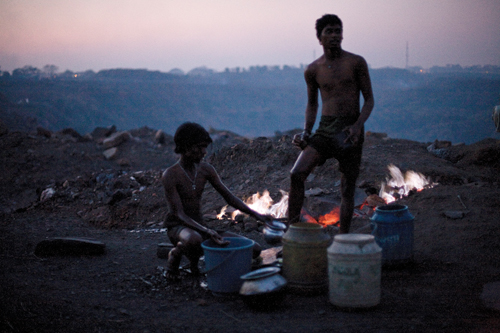At the center of Dhanbad City, in the Jharia region of northeastern India, amid a handful of concrete buildings, stands the enormous bronze statue of a coal miner. He is shirtless, muscular, and handsome. He strides doggedly forward, a mining helmet on his head, a pickax slung over his shoulder. The message is clear: Coal is my life. The area around Dhanbad produces India’s highest grade of coking coal, which in turn fuels the blast furnaces used for smelting steel. Contained in twenty-three large underground mines and nine open cast mines across an expanse of 450 square kilometers, Jharia’s heart of coal also produces power: two thirds of all electricity in India is generated in coal-fired plants. The earth beneath Jharia contains one of the largest coal reserves in the world.
But the coal is also on fire.
Mining started in Jharia in the 1890s, and by 1916 newspapers were reporting underground coal fires. According to these accounts, most fires started by spontaneous combustion; the deep mine tunnels had been improperly vented, leading to a buildup of volatile gases. Those fires have now burned for nearly a century, smoldering and spreading over 60 square kilometers, both at the surface and underground, with some fires reaching depths of 140 meters. More than 12 percent of the total deposits in the Jharia coalfields, or about 1.45 billion tonnes of coal, are now blocked from further development by these fires.
The land around Jharia is dominated by open mines laced with fissures and shafts, which act as bellows and chimneys, feeding and venting the subterranean fires. In some places, smoke, gases, and flames shoot up from the earth, and the ground has been known to collapse—sometimes with fatal consequences. Waterways are endangered, infrastructure has been destroyed, and even for those who step carefully, carbon monoxide, sulfur dioxide, and methane permeate the air, and many of the eighty thousand people who live in the region suffer from respiratory and skin problems.
Bokahapadi Village is the deadliest part of this deadly region, so when I arrived in Jharia, I wanted to see it. I had arranged to meet with Alok Gupta, a knowledgeable, English-speaking fixer who would set up visits and interviews in Bokahapadi. But Gupta never showed up, and I found myself in the bustle of Jharia, disoriented and alone. After spending several fruitless days trying to talk with officials at the coal company, I finally hired a taxi to drop me off in the center of Bokahapadi. From a throng of young people clamoring to be my guide, I found Deepak, a young man with functional English and his own motorcycle, who took me around for the next week and a half.
Bokahapadi is incredibly hot, even without the fires. The air is hot, the ground is hot, and the shade offers no relief. The only economic activity is mining. Those villagers who do not work for the companies scavenge coal illegally, bribing legal workers to let them into the mines for an hour or two every day. The scavengers, working solo or in small teams, pick away at the ground, searching for unburned lumps of coal and loading them into wicker baskets. Women and children as young as three then haul the heavy baskets over long steep gravel hillsides. They skirt the fires and walk through clouds of smoke and gas. In a certain light, the scavengers look like crews of the damned toiling in the furnaces of hell.
After a few days, Deepak offered to take me to the abandoned Bagdigi mine, where in 2001 more than thirty miners were trapped by flooding water. I rode on the back of his motorcycle for an hour through barren rocky terrain. We stopped at the edge of the mine and I looked down into what might as well have been a moon crater. I picked my way slowly down the steep rim and at the bottom I noticed a handful of children climbing into holes to pick coal. I had to crawl on my knees to reach the steep hollows where they worked. One eight-year-old girl told me she worked in the mines to help her family. For most of the other children, it was probably the same.
The villagers live in small, mud-brick houses, packing up to ten people in a room. In Bokahapadi, some of the houses stand within a hundred feet of open, smoking fissures. Because of the shifting terrain and weak building materials, many houses have cracks and caved-in roofs. One family told me their roof had collapsed one day while they were outside doing the washing; they were lucky. I also heard stories of an entire house that had slid into an open fissure, but I never found the site. If it was true, the fires had likely chewed it away into nothing. As I walked around, I soon realized that there were very few old people but many children and teens. People die young in Bokahapadi.
Early one morning, we went to the market where coal scavengers sold their store. I saw hundreds of men on the road pushing bicycles overloaded with bags of coal. They converged on a big, open market where piles of coal had been laid out on blankets like stacks of fruits and vegetables. I was soon swarmed by a dozen men who shouted, pointed, and yanked at my cameras. I asked Deepak to explain to them what I was doing, but they did not want to hear any of it. The last thing they wanted was to be photographed.
Another time, we came across a group of men in an open coalfield who scattered when they saw me. Deepak went after them and explained that I was not police—just a photographer. They let me watch their routine as they rigged a simple winching system over a small pit using some rope, hardware, and a few boards. One man climbed down the pit and loaded a basket with coal lumps, then the others winched it up, as though drawing water from a well. They were scavenging in an area that was still actively mined, but the company was powerless to stop them. Once they had extracted a basket of coal for each member of their team, they broke down the improvised winch and vanished.
-
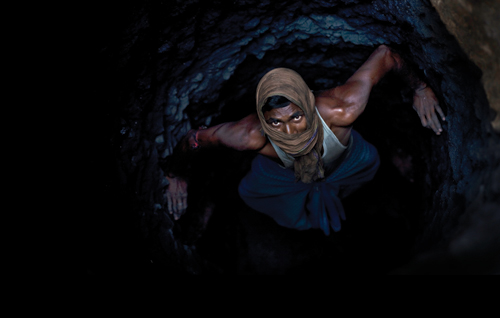
- A man crawls through a deep mine. The constant coal fires in Jharia send underground temperatures soaring.
Coal fires are notoriously difficult to combat, especially once they have burned for so long. In the 1960s, a coal fire began at the entrance to a mine in the town of Centralia, Pennsylvania, and quickly the flames burrowed underground, following seams of coal into spaces no human could follow. Several attempts have been made to extinguish it, but none have worked. Fires beneath Centralia eventually killed the town and drove away its residents. In southeast Australia, scientists believe a coal fire has been burning below ground for six thousand years. If apparently unstoppable fires still burned in Western nations, I wondered what could possibly be done in Bokahapadi.
I spoke to local managers at Bharat Coking Coal Limited, a subsidiary of the government-run Coal India. They told me they were perfectly aware that the conditions in Jharia and especially Bokahapadi were unacceptable, and they seemed genuinely concerned about the local people’s health and safety. They said they were pushing a program that would provide money to resettle tens of thousands of people away from the worst underground fires. But with frustration they told me the villagers were too stubborn to accept the offers. For their part, the villagers did not trust the government or the coal company. Generations ago, Jharia had arable land, but the fires and mining had slowly ruined most of the farming, like a plague spreading beneath the soil. The villagers wanted to see the government fight the fires and restore the land, but it was unclear that anybody could do that, even with unlimited resources. By one estimate extinguishing the fires by digging them up—the only reliable method—would cost $2.4 billion. It seemed unlikely that the Indian government would spend the money necessary to track the fires down and hunt them until they were dead.
So, for now, the villagers continue to dodge the fumes and flames, picking away at a seemingly endless reserve of coal, gathering the fuel that stokes the smelting fires of China and powers the call centers of Bangalore, even as the land is consumed from below.


